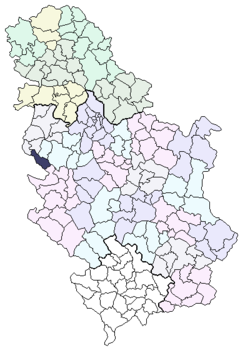
Crnca
Encyclopedia

Village
A village is a clustered human settlement or community, larger than a hamlet with the population ranging from a few hundred to a few thousand , Though often located in rural areas, the term urban village is also applied to certain urban neighbourhoods, such as the West Village in Manhattan, New...
in Serbia
Serbia
Serbia , officially the Republic of Serbia , is a landlocked country located at the crossroads of Central and Southeast Europe, covering the southern part of the Carpathian basin and the central part of the Balkans...
. It is situated in the Ljubovija
Ljubovija
Ljubovija is a town and municipality located in the Mačva District of Serbia. In 2011, the population of the town is 3,946 while the population of the municipality is 14,424.-Municipality:The municipality of Ljubovija includes the following settlements:...
municipality
Municipality
A municipality is essentially an urban administrative division having corporate status and usually powers of self-government. It can also be used to mean the governing body of a municipality. A municipality is a general-purpose administrative subdivision, as opposed to a special-purpose district...
, in the Mačva District
Macva District
Mačva District is a district of Serbia. The District expands in the western parts of Serbia, in the geographical regions of Mačva, Podrinje, Posavina, and Pocerina. It has a population of 297,778 people...
of Central Serbia
Central Serbia
Central Serbia , also referred to as Serbia proper , was the region of Serbia from 1945 to 2009. It included central parts of Serbia outside of the autonomous provinces of Kosovo and Vojvodina. The region of Central Serbia was not an administrative division of Serbia as such; it was under the...
. The village had a Serb ethnic majority and a population of 1,213, of whom 18 were Roma in 2002.
History
In mediaeval time Crnča was important mining and trade center of Serbian state during the 14th and 15th century. The mine and market at Lipnik located in present day Crnča were first time recorded in Ragusan archieves in 1319. as the place belonging to Serbian king Milutin. Lipnik was also mentioned as the place in Serbia with catholic parish in letter of pope Clement VI to king Stefan Dušan dated in 7 January 1346. By its present name Crnča was first time recorded in Ragusan archieves in 1367 (variously spelled in Italian and Latin as Cernca, Cernica, Crniza, Zrnza, Zerniza, etc) as a place with flourishing Ragusan trade and mining colony. In that time Crnča was famous for its silver mines founded by German miners called " Saxons " which were also attested in settlement in 1375 when Ragusan trader Bogavac Pribojevic bought parts of silver mines from some Germans (...de alguni Todeschi). Crnča was seat of major Ragusan colony which had its own Franciscan monastery of S.Maria and was headed by elected knez/comes/conte i.e. count, one of them being Ljubisa Vladojevic called " Brada " ( " The Beard " ). Most notable Ragusans who traded and lived in Crnča belonged to noble families belonging to House of Gučetić, Sorkočević, House of Crijević, Gundulić, House of Lukarić and Ranjina. Crnča was also seat of diverse crafts with numbers of tailors, goldsmiths, furriers and candle makers mentioned in Ragusan sources. Crnča reached its peak in second half of 15th century during the time of despots Stefan LazarevićStefan Lazarevic
Stefan Lazarević known also as Stevan the Tall was a Serbian Despot, ruler of the Serbian Despotate between 1389 and 1427. He was the son and heir to Prince Lazar, who died at the Battle of Kosovo against the Turks in 1389, and Princess Milica from the subordinate branch of the Nemanjić dynasty...
and Đurađ Branković when it was one of the richest mines of Serbia along with Novo Brdo
Novo Brdo
Novo Brdo is a town and municipality in the Pristina district of eastern Kosovo. The population of the municipality is estimated at 6,720 people .-History:...
, Srebrenica
Srebrenica
Srebrenica is a town and municipality in the east of Bosnia and Herzegovina, in the Bosnian Serb entity of Republika Srpska. Srebrenica is a small mountain town, its main industry being salt mining and a nearby spa. During the Bosnian War, the town was the site of the July 1995 massacre,...
and Rudnik
Rudnik
Rudnik is a mountain in central Serbia, near the town of Gornji Milanovac. Its highest peak Cvijićev vrh, named after geologist and biologist Jovan Cvijić, has an altitude of 1132 meters above sea level...
. In 1459 Crnča fell under Ottoman
Ottoman Empire
The Ottoman EmpireIt was usually referred to as the "Ottoman Empire", the "Turkish Empire", the "Ottoman Caliphate" or more commonly "Turkey" by its contemporaries...
rule with rest of the Serbia and started to decline as mining and trade center with Ragusan colony disappearing by 1471. By the 1519 Crnča is no longer mentioned as a mine although Ottomans brought new law for mine of Crnča in 1488. In later periods Crnča and surrounding areas became part of Ottoman has (sultan's estate) of Bukovica.
Historical population
- 1528: 37 Christian homes, 3 Muslim homes
- 1530: 30 homes
- 1536: 16 homes
- 1559: 14 homes
- 1572: 15 homes
- 1948: 1,438
- 1953: 1,569
- 1961: 1,783
- 1971: 1,707
- 1981: 1,539
- 1991: 1,373
- 2002: 1,213

